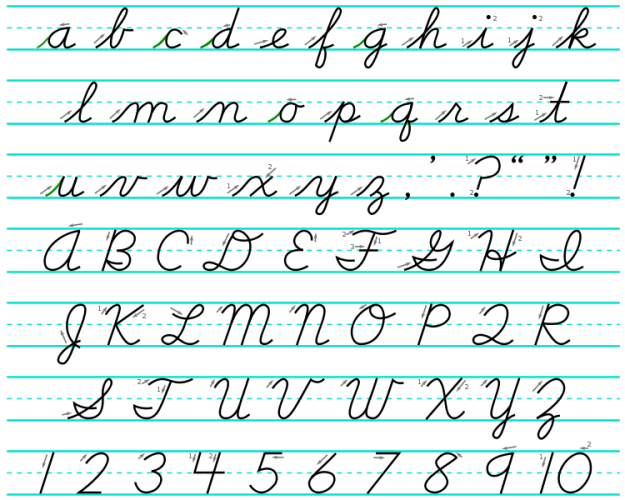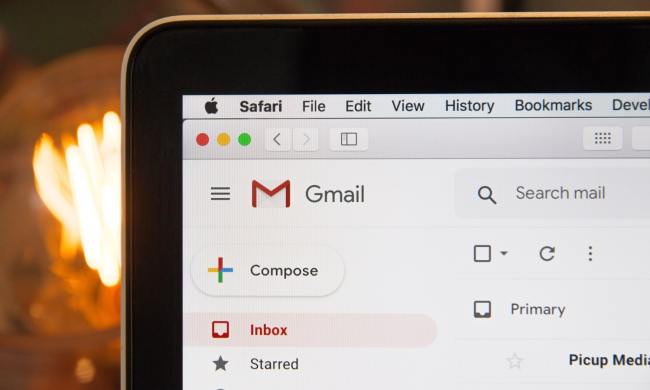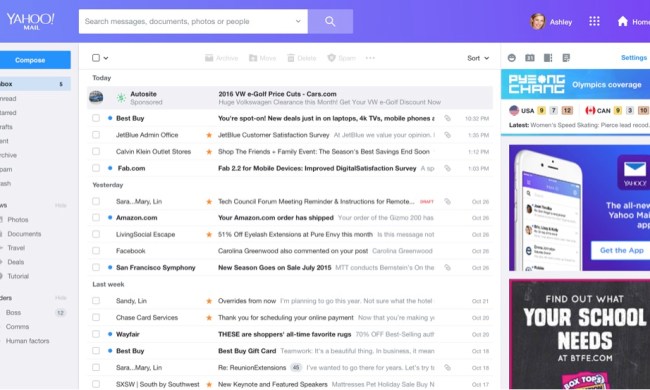 One of the very first things you learn to do is to write. In school, you were forced to follow a handwriting rule book along with your peers, so at first every person’s penmanship looked the same, but as you got older, your writing started to develop characteristics unique to you. From the very first moment you put squiggled lines on paper, you were already developing a personality that could be tied to what would later on become your regular penmanship. Yes, the idea of finding out what a person is like based on his or her chicken scratch is an old one – there are more than a few businesses dedicated to analyzing how you dot your i’s and cross your t’s and what this says about you.
One of the very first things you learn to do is to write. In school, you were forced to follow a handwriting rule book along with your peers, so at first every person’s penmanship looked the same, but as you got older, your writing started to develop characteristics unique to you. From the very first moment you put squiggled lines on paper, you were already developing a personality that could be tied to what would later on become your regular penmanship. Yes, the idea of finding out what a person is like based on his or her chicken scratch is an old one – there are more than a few businesses dedicated to analyzing how you dot your i’s and cross your t’s and what this says about you.
But more importantly, handwriting analysis lends a big hand to cracking criminal cases – we’ve all seen enough episodes of CSI to prove as much. Handwriting analysis is a very important aspect of forensic science and sometimes a crucial method for catching certain types of criminals, which is why it was a bit of a surprise when The Georgia Bureau of Investigation recently shuttered its Handwriting Analysis Unit after being in action for 20 years.
“Just as no two fingerprints are alike, neither are two handwriting samples the same.”
According to local news outlet Online Athens, the unit was actually temporarily suspended a year ago to give GBI analysts time to attain accreditation after they failed to meet requirements imposed by the American Society of Crime Laboratory Directors. According to a report, “Handwriting analysis has dwindled in importance to prosecutors over the years. Tests for DNA and firearms matching and drug and alcohol screenings are far more critical to criminal prosecutions. Handwriting analysis is most often useful in forgery cases.” Now that the unit is officially closed, agencies that rely on its forensic document examination services will have to hire private consultants.
With handwriting analysis pegged to “go the way of snail mail and cursive penmanship,” does it mean handwriting as a practice and art is sure to fade away as well? Is there a future for the act of holding pen and pencil to paper?
The psychology of pen and paper
Graphology is the pseudo-scientific study of handwriting, mostly used in relation to human psychology. Kathi McKnight, Master Graphologist and author of various books on the matter, believes that a person’s handwriting reveals one’s core, true, and authentic nature very quickly, including the complexities of your personality that usually remain unknown until much later in life. “Just as no two fingerprints are alike, neither are two handwriting samples the same,” explains McKnight. “There are about 5,000 things that handwriting can and does reveal. Handwriting is actually brain writing. It’s not the hand, but the nerve impulses from the brain that control the pen and what it splashes onto the paper.”

Forensic examiners critically scrutinize documents included in evidence in order to produce a timeline of events leading up to the crime, as well as possibly pinpoint a likely suspect based on handwriting characteristics. Sheila Kurtz is a Master Graphologist and Managing Director of Graphology Consulting Group (GCG), a company that also offers forensic handwriting analysis in civil and criminal matters. GCG’s service includes a comprehensive evaluation that picks apart at least 250 traits in order to paint an accurate graphic picture of one’s personality. “[Handwriting analysis] is a non-discriminatory assessment method – it can’t discern age, origin of birth, or gender,” explains Kurtz as to why she is fascinated by the method and why she remains steadfast in her profession.
A forensic analyst will leave no stone unturned when it comes to breaking down handwriting and will examine the following traits:
- Handwriting form – size, shape and slant of the letters, as well as angle, connection, and curve of every letter placement
- Line quality – thickness of the line in terms of writing instrument used and pressure applied, as well as the speed of writing
- Format – spacing between letters and words, placement, margin use, and alignment
- Content – grammar, spelling, phrasing, and unique punctuation
- Miscellaneous – writing instrument, type of paper, type of ink
Some of these traits are also considered in the art side of handwriting analysis, and in both instances can be used to reveal more about the person whose writing is being studied.
Aside from psychological analysis for personal and government use, handwriting analysis has broad uses. Allan Grim specializes in handwriting analysis for businesses and organizations and uses his expertise to provide insight into the personality of potential new hires and candidates for promotion, but he cites a few examples of the questions he regularly gets asked by clients. “Most of my practice [involves] people with specific questions about themselves or someone they must deal with,” says Grim. “[What was our] son going through when he committed suicide? What about my fiancé should make me pause and think before I marry him? Which of these people is most likely the one that sent this nasty anonymous letter to our daughter? What career path should my son follow based on his personality?”
People who are looking to discover “road blocks” that hold them back from attaining their full potential can also venture into Grapho-therapy, which Knight defines as the science of changing one’s writing to affect change in one’s life by affecting neuro-pathways in the brain. Handwriting analysis has also been known to assist in medical diagnosis, jury screening, genealogical research, and aiding troubled children.
The case for cursive and calligraphy
When you think about handwriting and penmanship, you almost immediately think of cursive, which Bill Kemp – President of The International Association of Master Penmen, Engrossers and Teachers of Handwriting (IAMPETH), an international, non-profit association dedicated to practicing and preserving the beautiful arts of calligraphy, engrossing and fine penmanship – believes is a life-long skill. “In the 1700’s and earlier there were two forms of reading. There was the printed work, such as a book or bible, and the written word, handwritten documents, or letters. Knowing how to read and write cursive allows the individual to communicate with anyone that can read the written word,” says Kemp. Despite the rich history, more and more educational institutions are removing American cursive and overall teaching of penmanship from their curriculums, driven by the idea that math, science, and reading are more important.
Calligraphy, or “beautiful writing,” on the other hand, is a field that is drawing more and more young people to it every year, according to Harvest Crittenden, Master Penman and Director of The Spencerian Saga. “There are many young, exciting calligraphers who are putting their own mark on the field of calligraphy. Pointed pen, broad pen, ruling pen, chalk, ink, paint are all being used to letter in new ways. And there is a real resurgence of interest in the areas of calligraphy, certificate making, illumination, and the sacred arts,” explains Crittenden.

Michael Sull, a dedicated Master Penman, recently wrote a book in an effort to provide a vehicle for people – especially young people – to learn American cursive. “I hope to promote the recognition and encouragement of learning – and using – [cursive] in our children and among adults who recognize the degree to which they have lost the humanity of communication,” says Sull. “There has always been a personal joy among people in the contemplation and reflection that are inevitably involved in handwriting. I believe that this is an invaluable human trait that should not be lost to technology.”
“As an advocate of the beauty of the handwritten word, I continue to visit various schools and give calligraphy demonstrations, hold ongoing local calligraphy classes at my studio location for both teens and adults, and teach, lecture and mentor nationally,” says Kathy Milici, a calligrapher with particular interest in handwriting analysis and a member of The IAMPETH.
Down – but not out
At the root of it all, the biggest reason why handwriting and other related practices are considered archaic is because … well, they are. If you compare the ancient practice of written words to the constantly developing, next-gen”ness” of technology, there’s no argument over efficiency and ubiquity. Digital wins, hands down. People are more prone to type on a keyboard because it’s easier and quicker, and online communications is simply faster and able to accomplish more. You can insert a GIF or attach a spreadsheet to a letter. And a delivery time of a minute or less is hard to bear. But according to experts, efficiency and data transfer aren’t what handwriting is all about.
“In a larger sense, there is much more significance to the subject of handwriting than solely the relaying of information,” states Sull. “However, with the ever-increasing demand for ‘instant communication’, the other ‘human’ aspects of handwriting are all but forgotten.”
The educational system may also be partly at fault for de-prioritizing handwriting and penmanship as a subject in school, forgetting the fact that reading – which is one of the most highly regarded skills developed during the early stages – is hugely dependent on one’s ability to form and write the letters on paper. “Most teachers have no idea how the alphabet developed,” says Gregory MacNaughton, Calligraphy Initiative Coordinator at Reed College’s Douglas F. Cooley Memorial Art Gallery. “Learning about the letters, how the letters are made, the stroke order and shape of the letters while embodying these forms through the physical act of writing them are enormously important developmental milestones in the teaching of basic literacy.”
“The way the brain is developing during this ongoing exercise, not to mention the fine motor skills and eye-to-hand coordination, is of vital importance for a child’s growth and development.”
Despite reproaching the inadequacy some teachers show on the subject, MacNaughton says he doesn’t fear for the future of the handwritten word – he sees people’s strong tendency to create beautiful things with their hands and believes it is a good sign. “The invention of photography was hailed as the end of drawing, but has drawing died, or lithography, copper plate engraving?” No, they have not; Reed College was in fact the institution where Steve Jobs took calligraphy classes that inspired how Apple’s fonts were designed.
While there’s a digital solution to nearly everything tangible, there’s a possibility that this will actually work in handwriting’s favor. “With the increase of technology in our daily lives, I believe that need [to express ourselves and leave our mark] is stronger, not weaker,” says Crittenden. “While email is wonderful for quick answers and business communication I don’t believe it will ever replace the handwritten note. It doesn’t fill the same need.” There’s a reason we write in Sharpie on Polaroids, and sign birthday and greeting cards by hand – our unique loops and letters show our feelings better.
Grim agrees that the decline of handwriting has probably resulted in fewer questioned document cases, but he believes it is far from obsolete. “I believe that we will always have the need to solve cases such as forgeries of legal documents, like wills, financial items, checks, and other items where a signature is needed and people will always make anonymous writings with pen and pencil, such as graffiti, nasty notes, threatening comments, suicide notes (Is it real or a murder and made to look like suicide?), school writings on walls or other surfaces by troubled students.”
There’s also one thing we all ought to know well about technology – although it is fast-paced and constantly updating, it doesn’t always work. Electronic devices can run out of power or can be stolen, or maybe you – gasp – lost Wi-Fi. When Murphy’s Law hits you hard and all else fails, you can always turn to manually writing things down.
As far as education goes, it starts at home – parents still have the option to pass on the knowledge to their children. Furthermore, learning cursive at a young age has been scientifically proven to improve cognitive function. “There are certain areas of the brain that ‘light up’ as a child is learning to connect letters on paper, while holding a pen or pencil,” says Milici. “The way the brain is developing during this ongoing exercise, not to mention the fine motor skills and eye-to-hand coordination, is of vital importance for a child’s growth and development.”
Handwriting analysis expert Anuj Magazine is very optimistic about what the future holds for handwriting analysis as both an art and a science. “I believe handwriting as a means of expressing thoughts is going nowhere, but like with many things with life around us (because of advancement in technology), it is undergoing a shift,” Magazine says. “If [it] stays and becomes more powerful, the world will be a better place in which people understand each other better, the organizations will have less [people-related] conflicts, and a lot of people-specific decisions can be taken quickly and accurately.”
Surviving a next-gen-obsessed era
In order to retain the acceptance of handwriting analysis as a relevant science, Magazine believes it needs an upward push from the community that endorses it.
“One of the biggest problems is that, due to the inherent low level of technology (you only need a pencil or a pen and some paper), there’s no great monetary profit in a ‘handwriting industry’ as there is in the electronic industry where products become outdated instantly and must be frequently re-purchased by the customer,” says Sull. “But, if the inherent joy – or personal benefits – of handwriting can be effectively promoted, I think (and hope) that there is enough humanity remaining in people for it to be considered as a desired ‘retro-skill’ of personal expression.”
The availability of the Internet and the technology that goes with it may make it easy for you to dismiss the merits of the handwritten word, but there’s something to be said for the fundamentals. “We don’t have the political will to support the public education system that our children deserve and we are looking for places to make cuts,” says MacNaughton. “In the name of making our children competitive in a global marketplace (and emphasizing the teaching of science and math to a fault), we are willing to deprive them of some of the most basic human activities such as learning how to write a handwritten love letter or simply making something beautiful with their own hands.”


